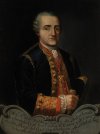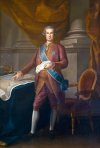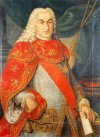Frederick: King, Elector and Emperor ii
Frederick’s long-awaited accession to the throne occasioned a shake-up in the alliances then prevailing in the House of Commons. Contrary to some of the more hysterical predictions from Whig propagandists of the 1740s, Frederick’s accession did not cause the wholesale replacement of the traditional Whig ruling party but it did mean that the pieces were thrown into the air and did not come down to land until some time later. By 1750 we can see the broad outlines of three general groupings. These help us conceptualise the political disagreements of the era but it should be noted that these groupings were protean and they by no means always acted in concert.
The dominant groupings were the Patriots and the Court Whigs, the former of whom had been brought to power by Frederick’s accession. The most notable Patriots, of course, were Lord Carlisle, who became prime minister in 1743, as well as future prime ministers William Pitt and Lord Egmont, but the grouping included important figures such as George Grenville and George Lyttleton. Temperamentally, this grouping opposed government corruption and supported Frederick albeit with concerns about the potential for executive overreach. On questions of political economy, most supported a general belief in the improving nature of trade and finance, while on foreign policy a general antipathy towards large standing armies was contrasted with strong negative views towards other European powers, especially France and Spain, who threatened Britain’s American and West Indian colonies.
The Court Whigs was the name given to those who still followed the Pelham brothers as the heirs to Walpole. They considered themselves to be the upholders of the principles that had governed Britain since 1714 until the Patriots had usurped them. Several of the Court Whigs, particularly the Pelhams, remained influential members of the government and used what control they had over patronage to ensure that their grouping was arguably the most orderly and functional of all the factions in Parliament at the time. Indeed, to a great extent the end of the Whig Oligarchy was the best thing that could have happened to Whiggism after the division and struggles of Walpole’s later premiership as it gave them, in the form of the Patriots, an opponent who was really competing with them for power. Generally the Court Whigs favoured religious toleration, protectionist trade and moderate economic reforms, while being uncomfortable both with political radicalism and excessive exercise of the royal prerogative.
The final grouping has been called, at the time and since, the County Party but this does not really do justice to the nature of the beast. The only thing which all of these things had in common was that they were not in government and, in most cases, had no plausible avenue for entering it. On the one hand the Country Whigs, long reconciled for a variety of reasons to not entering government, saw themselves as upholding real Whig values which had not been corrupted by faction or government. Resolving to judge governments based on “measures, not men,” this diverse grouping lacked a real leader and occasionally ground themselves in a pro-government position and sometimes in opposition. What really unified them as a group was a stated commitment to Whig ideals and position outside government.
The Country Whigs are occasionally placed alongside another opposition faction: the Tories. Almost driven out of business by the harsh proscription of the two Georges, as with the Court Whigs the accession of Frederick also breathed life into an organisation that had become almost totally moribund. Although he was careful not to bring too many famous Tories, notably Bolingbroke, into government in 1743, Frederick did bring in other notable Tories such as Lord Beaufort and Sir John Cotton. Overall, however, toryism remained an oppositional ideology, with Tories valuing their status as independent men, supporting English liberty, deference to the Crown and opposition to needless foreign entanglement.
The final grouping, and the smallest, were known as the Radicals or Commonwealthmen. Usually elected from one of the populous urban constituencies, they strongly supported radical religious and political reform. They condemned corruption and lack of morality in British political life, theorising that only civic virtue could protect a country from despotism and ruin. On the other hand, this often led them to adopting the extreme xenophobic or anti-semitic views held by many of their constituencies.
As stated, these descriptions are necessarily vague, but we can draw up the following tabulation of MPs elected in the 1743 election:
Patriots - 223
Court Whigs - 206
Country Whigs - 72
Tories - 49
Radicals - 8
The Court Whigs and the Patriots were in government together for almost all of Frederick’s reign and some, not least opposition satirists, noted that there was little to mark a division between the two of them. On the other hand, if there is anything that political history has taught us, it is that seemingly-superficial differences do matter. Frederick continued to use Leicester House as his main residence in London and the Patriots made sure that their meetings were held either there or at Cobham’s residence, Stowe House. The Court Whigs, meanwhile, took to congregating at Newcastle House, the residence of the Pelhams in London, and the Tories at Bolingbroke House in Surrey. The Radicals and the Commonwealthmen lacked such a base but, by charting the three great houses out on a map of London, we can begin to see the origins of the famous points of the political compass: the North, the South, the West and the East.
– from ‘Frederick: King, Elector and Emperor’ (2012)
The dominant groupings were the Patriots and the Court Whigs, the former of whom had been brought to power by Frederick’s accession. The most notable Patriots, of course, were Lord Carlisle, who became prime minister in 1743, as well as future prime ministers William Pitt and Lord Egmont, but the grouping included important figures such as George Grenville and George Lyttleton. Temperamentally, this grouping opposed government corruption and supported Frederick albeit with concerns about the potential for executive overreach. On questions of political economy, most supported a general belief in the improving nature of trade and finance, while on foreign policy a general antipathy towards large standing armies was contrasted with strong negative views towards other European powers, especially France and Spain, who threatened Britain’s American and West Indian colonies.
The Court Whigs was the name given to those who still followed the Pelham brothers as the heirs to Walpole. They considered themselves to be the upholders of the principles that had governed Britain since 1714 until the Patriots had usurped them. Several of the Court Whigs, particularly the Pelhams, remained influential members of the government and used what control they had over patronage to ensure that their grouping was arguably the most orderly and functional of all the factions in Parliament at the time. Indeed, to a great extent the end of the Whig Oligarchy was the best thing that could have happened to Whiggism after the division and struggles of Walpole’s later premiership as it gave them, in the form of the Patriots, an opponent who was really competing with them for power. Generally the Court Whigs favoured religious toleration, protectionist trade and moderate economic reforms, while being uncomfortable both with political radicalism and excessive exercise of the royal prerogative.
The final grouping has been called, at the time and since, the County Party but this does not really do justice to the nature of the beast. The only thing which all of these things had in common was that they were not in government and, in most cases, had no plausible avenue for entering it. On the one hand the Country Whigs, long reconciled for a variety of reasons to not entering government, saw themselves as upholding real Whig values which had not been corrupted by faction or government. Resolving to judge governments based on “measures, not men,” this diverse grouping lacked a real leader and occasionally ground themselves in a pro-government position and sometimes in opposition. What really unified them as a group was a stated commitment to Whig ideals and position outside government.
The Country Whigs are occasionally placed alongside another opposition faction: the Tories. Almost driven out of business by the harsh proscription of the two Georges, as with the Court Whigs the accession of Frederick also breathed life into an organisation that had become almost totally moribund. Although he was careful not to bring too many famous Tories, notably Bolingbroke, into government in 1743, Frederick did bring in other notable Tories such as Lord Beaufort and Sir John Cotton. Overall, however, toryism remained an oppositional ideology, with Tories valuing their status as independent men, supporting English liberty, deference to the Crown and opposition to needless foreign entanglement.
The final grouping, and the smallest, were known as the Radicals or Commonwealthmen. Usually elected from one of the populous urban constituencies, they strongly supported radical religious and political reform. They condemned corruption and lack of morality in British political life, theorising that only civic virtue could protect a country from despotism and ruin. On the other hand, this often led them to adopting the extreme xenophobic or anti-semitic views held by many of their constituencies.
As stated, these descriptions are necessarily vague, but we can draw up the following tabulation of MPs elected in the 1743 election:
Patriots - 223
Court Whigs - 206
Country Whigs - 72
Tories - 49
Radicals - 8
The Court Whigs and the Patriots were in government together for almost all of Frederick’s reign and some, not least opposition satirists, noted that there was little to mark a division between the two of them. On the other hand, if there is anything that political history has taught us, it is that seemingly-superficial differences do matter. Frederick continued to use Leicester House as his main residence in London and the Patriots made sure that their meetings were held either there or at Cobham’s residence, Stowe House. The Court Whigs, meanwhile, took to congregating at Newcastle House, the residence of the Pelhams in London, and the Tories at Bolingbroke House in Surrey. The Radicals and the Commonwealthmen lacked such a base but, by charting the three great houses out on a map of London, we can begin to see the origins of the famous points of the political compass: the North, the South, the West and the East.
– from ‘Frederick: King, Elector and Emperor’ (2012)



